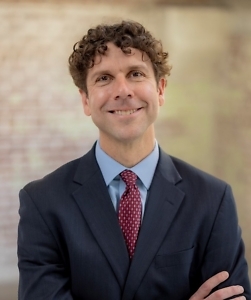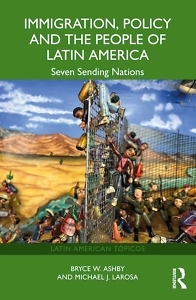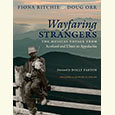Latin Lessons
Bryce Ashby and Michael LaRosa bring historical and personal insight to the immigration debate
In the recent presidential election, immigration across the Mexican border was a hot-button issue. In
Immigration, Policy and the People of Latin America, Bryce Ashby and Michael LaRosa seek to understand migration into the United States from the perspective of Latin Americans. Combining history, policy, and personal profiles of migrants, they illuminate the diverse experiences of migrants from Mexico, Guatemala, Honduras, Cuba, Haiti, Venezuela, and Colombia.

Ashby and LaRosa have collaborated on numerous opinion pieces for the Commercial Appeal, Memphis Flyer, and Daily Memphian. This is their first book together. Ashby is a labor attorney at Donati Law and a former Peace Corps volunteer in Honduras. LaRosa is an associate professor of history at Rhodes College who has published widely on the history of Colombia, including Colombia: A Concise Contemporary History, which has gone into a third edition (2023) and was translated into Spanish.
They answered questions via email from Chapter 16:
Chapter 16: In both the 2016 and 2024 elections, Donald Trump capitalized on hostility to immigration across the Mexican border. Do you see your book as a response to this political trend?
Bryce Ashby and Michael LaRosa: The answer is both yes and no. Trump did not start the anti-immigrant movement — he just perfected it. But remember back to 2006 when hundreds of thousands of pro-immigrant supporters took to the streets of cities across the United States in support of immigration reform, including nearly 10,000 in Nashville and at least 4,000 in Memphis. For more than 20 years, America has been in a vigorous public debate about immigration and immigration policy.
We wrote the book in the hopes that we could put the current vitriol in the context of a long history of shifting public sentiment. We sought to remind readers of the issue’s complexity, which is often seen as a domestic concern, though it largely stems from decades of American foreign policy blunders and missed opportunities. Lastly, we wanted to point readers away from the demagogues and back to the human beings who uprooted their lives and journeyed thousands of miles for a chance at a better life in the U.S.
Chapter 16: How did you choose the “seven sending nations” analyzed in the book? What do the distinctions in their histories reveal about American immigration?

Ashby and LaRosa: Nearly every country in the Americas has a historical immigration relationship with the U.S.; we could have chosen 20 nations, the number of nations in Latin America. We chose these seven countries for a mix of practical and historical reasons. Mexico is the most important nation — historically and geographically — in the immigration narrative, but we wanted to include a couple of nations from Central America, one of which, Honduras, was Bryce’s home during his 27-month Peace Corps tour in the early part of this century. Mike has studied and periodically lived in Colombia for decades. Venezuela is currently undergoing a massive out-migration (maybe 30 percent of the national total), due to corruption, weak leadership, and a recent national election that was anything but democratic. And Haiti has this rich historical tension with the U.S. and has undergone a nearly complete deterioration of its government and rule of law that has led to massive emigration north.
Chapter 16: Let’s focus on one of these nations: Mexico. What can we learn from Mexican history, American policy, and the experiences of Mexican-American immigrants?
Ashby and LaRosa: Mexico is huge! We share a nearly 1,000-mile border with the nation of 125 million to our south. Mexico is, by far, the leading trade partner of the United States. These factors influence the labor market, migratory processes, and cultural exchanges. Building a “beautiful wall” failed in the past and will fail in the future. Walls don’t work, unless you want to become China or Communist Berlin!
The Mexicans remember, better than Americans, the intricate history of our two nations. Mexican school children study the 1846 war, “The War of North American Aggression” [as they refer to it], when the nation lost 51 percent of its territory, plus much of its mineral wealth, to the United States. We took the land, after a protracted war, because we wanted the land and planned to expand slavery. Hardly noble goals.
So conversation and diplomacy with Mexico is critical to our national well-being. Claudia Sheinbaum, the new president of that nation, has reacted to President-elect Trump’s threat of tariffs on incoming Mexican goods with … the same threat on incoming American goods. She has the economic leverage to make good on her retaliatory plan, but no one really wants to see a big American trade war beginning on January 21!
Chapter 16: Why did you choose to conduct interviews with immigrants from Latin America? What was that process? How did it shape the texture of your book?
 Ashby and LaRosa: Often lost in the discussion of U.S. immigration history and policy are the people — the individuals and families who make these journeys and whose everyday lives are affected by the laws and swings in public sentiment on immigration. We wanted to include at least a few stories of people from each country as a reminder that when we are talking about immigration, we are talking about human beings.
Ashby and LaRosa: Often lost in the discussion of U.S. immigration history and policy are the people — the individuals and families who make these journeys and whose everyday lives are affected by the laws and swings in public sentiment on immigration. We wanted to include at least a few stories of people from each country as a reminder that when we are talking about immigration, we are talking about human beings.
Our plan initially had been to include photos and use the real names of all the individuals we chose to highlight. It became clear that while people were interested in telling their stories, most were less interested, given the current political climate, in having their faces and real names included in a book, regardless of their immigration status. So we had to transition to pseudonyms and abandon the use of photos. We still think we managed to tell their stories and remind readers that we are talking about our neighbors when we talk about immigration, but we think we missed some of that power by not being able to include their photos.
Chapter 16: Together you have written editorials for a variety of Memphis publications, and now you have co-authored this book. How did your partnership arise? How did it evolve while writing this book?
Ashby and LaRosa: We’ve been a team for a long time and have published over 100 op-eds and other pieces related to the Hispanic community in Memphis and the nation writ large. The partnership emerged after Bryce completed law school and saw a myriad of abuses of workers and undocumented persons in his practice, and he felt the wider community needed to know about these realities. We never, of course, mentioned names.
Few people in Memphis were writing about the immigrant community, and so we found a sort of “niche” market. We also counted on very good editors at the local papers — specifically at the Memphis Flyer and Daily Memphian. As we learned more through this volunteer journalism work, we decided to put together a book manuscript. We were fortunate to secure a contract at Routledge, and the book was published on November 20, 2024, a couple of weeks after the U.S. presidential election.

Aram Goudsouzian is the Bizot Family Professor of History at the University of Memphis. His most recent book is The Men and the Moment: The Election of 1968 and the Rise of Partisan Politics in America.





